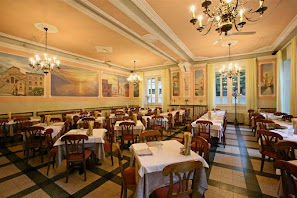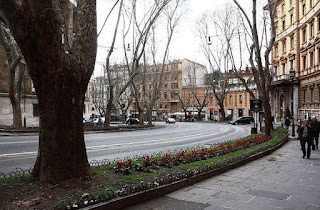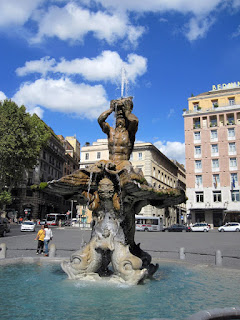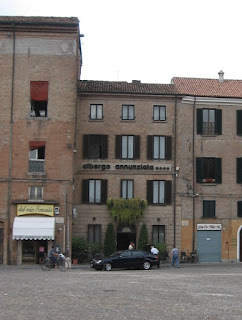Historic
residence with wonderful views over the countryside
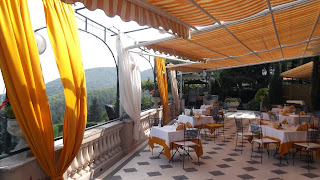 |
The Hotel Scapolatiello's elegant dining
terrace overlooks beautiful countryside |
In the
wooded hills above Cava de’ Tirreni, which is ten kilometres (six miles)
northwest of the town of Salerno, the Hotel Scapolatiello is the perfect place
for a relaxing break.
Located
in a wonderful position overlooking the surrounding countryside, Hotel
Scapolatiello has large, comfortable guest rooms, a garden with a swimming pool
and a restaurant that serves breakfast, lunch and dinner.
You can
eat in either the elegant dining room or on the terrace looking out over the
garden. The restaurant takes pride in using local cheeses, fruit and vegetables
and has its own label wine and preserves. The menu features some unusual
antipasto combinations, risotto, pasta and meat dishes.
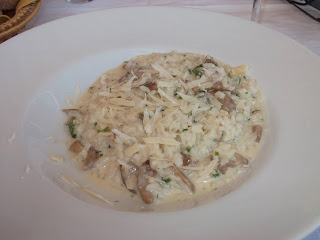 |
The Scapolatiello's risotto with mushrooms
and savings of provola cheese |
The Hotel
Scapolatiello first opened its doors to visitors in 1821 and has entertained
many of the famous people who have visited the nearby L’Abbazia della
Santissima Trinita, known locally as La Badia. One of the most important
religious centres in southern Italy, La Badia celebrated its 1000th anniversary
in 2011.
Hotel Scapolatiello
is in Piazza Risorgimento in the centre of Corpo di Cava, a small walled
village three kilometres to the south of Cava de’ Tirreni.
Editor’s
note
‘I have
lovely memories of enjoying lunch on the terrace of the historic Hotel
Scapolatiello overlooking their immaculate garden. I was given complimentary
mini calzoni filled with cheese, tomatoes and ham before the risotto with
provola that I had ordered. I sampled the hotel’s own label Falanghina, which
was delicious.’
What to see in Cava de' Tirreni
Cava de’
Tirreni may not be as well known as Naples, Sorrento and Salerno, but it was
once the preferred stopping off place for travellers on the Grand Tour visiting
Pompei, the Amalfi coast or Paestum
For
centuries, Cava enjoyed a free port at Vietri sul Mare and became prosperous
through trading in silk tapestries, leather goods and ceramics. The city also
became known for its skilled engineers and craftsmen..
 |
Cava de' Tirreni's porticoed streets provide
shelter from the summer heat
|
Cava was
given the full name Cava de’ Tirreni, acknowledging its earliest known inhabitants,
after Italian unification in 1861 and it has remained an elegant, civilised
town with beautiful architecture
The city
has earned itself the title of ‘the Bologna of the south’ because of its half
kilometre of elegant porticoed streets in the centre. The oldest porticoes were
built in the 15th century in front of single storey shops so that goods could
be displayed and trade carried out sheltered from the sun. At 47km (29 miles) south of Naples, Cava is hot during the summer.
The
traders built living accommodation over their shops and many of the buildings
have ornate facades and pretty balconies. Today, fashion boutiques, wine bars,
restaurants and pastry shops do business behind the ancient porticoes..
Intriguing
glimpses of the mountains on both sides of Cava de’ Tirreni can be seen from
the end of many of the streets. Look out for Monte Castello, a triangular
shaped mountain with a castle on the top, which appears in the skyline at
different places in the centre of town.
The
Abbazia Benedettina della Santissima Trinità - known also as La Badia di Cava - is three kilometres from the
centre of Cava de’ Tirreni. Behind the 18th century façade lie the original
11th century church and cloisters, a chapel with a magnificent 15th century
majolica floor and a museum and library. The abbey was built in 1011 after a
nobleman, Alferio Pappacarbone, retired to the area to pray and other
worshippers gathered around him. La Badia went on to become the religious hub
of southern Italy and Pope Bonifacio IX made Cava a city in its own right, separate
from Salerno, in 1394. The abbey was given a baroque facade in the 18th century
but retains its original architectural details inside.
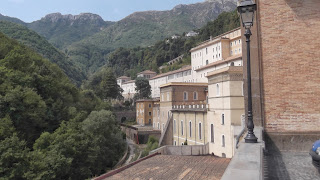 |
La Badia nestles in the wooded hills a few
kilometres outside Cava de' Tirreni |
Cava de’
Tirreni is surrounded by hills with pretty villages that have medieval towers,
built for a dove hunting game. Starting from Annunziata you can follow a
circuit, passing eight towers along the way, before arriving back at the same
village.
North of
Cava de’ Tirreni lies the nature park of Diecimare, also known as Parco Due
Golfi because it has views over the bay of Naples and Vesuvius to the north and
the bay of Salerno to the south. It is home to beautiful plants, flowers, birds
and animals and visitors can choose to follow different panoramic paths.
There are
regular trains and buses to Pompei, which is half an hour away from Cava de’
Tirreni. As well as the world famous scavi, the excavated remains of the
original Roman town, Pompei has a church that has become a centre for pilgrims,
il Santuario della Beata Vergine del Rosario in Piazza Bartolo Longo.
Cava de’
Tirreni has become known as ‘the green gateway to the Amalfi coast’ as it is
close to the resort of Vietri sul Mare and the village of Cetara, where
you can sample their famous pasta dish, spaghetti with colatura di alici, a
type of sauce made from anchovies, thought to derive from an ancient Roman
recipe.
Eating
out in Cava de’ Tirreni
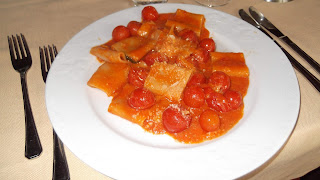 |
Pacheri allo scarpiello, with fresh tomatoes,
is a Cava speciality dish |
On
restaurant menus you will see pacheri, the local tube shaped pasta, served
either allo scarpariello with ‘shoemaker’s sauce’ made with fresh tomato,
cheese and basil, or con carciofi e provola (with artichokes and cheese).
There are
many dishes featuring fresh, local fish and southern Italian classics such as
fritto misto.
Light
dry, fragrant Falanghina is a white wine that goes perfectly with fish and
dishes made with mozzarella, such as insalata caprese. Cava de’ Tirreni is in
the prime territory for the best Falanghina wines made from grapes grown on the
slopes of Vesuvius, along the Sorrentine peninsula or near the Amalfi coast.
Book a stay at the Hotel Scapolatiello
Home
.jpg)



